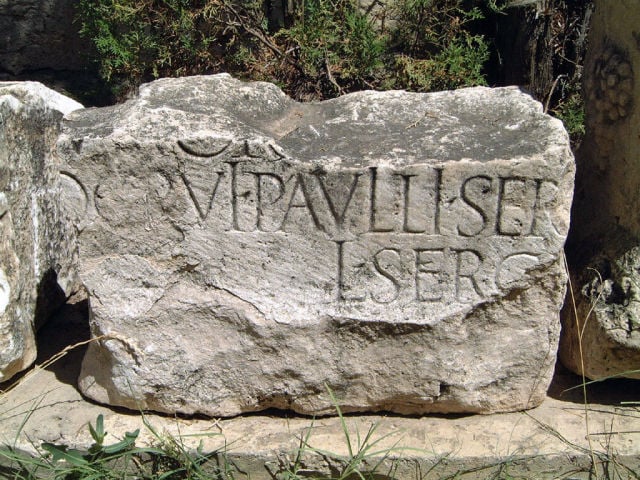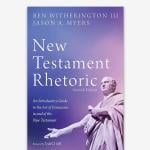Here is a limestone inscription about the Sergius Paulus family, who were from Pisidian Antioch, the place Paul visited on his first missionary journey. Notice that at the end of the line the name Sergius is cut off in both the first and the second lines of inscription. If this can happen on a stone inscription, it was all the more likely to happen with fragile papyri. And here is where I mention that ancients were no better than moderns during the age of video tapes, where Blockbuster would have an inscription saying ‘please be kind and rewind’ but alas, the patrons often didn’t. This sadly was also true with ancient papyri. A person would scroll right through the manuscript, finish reading, and then no bother to rewind the scroll! This apparently happened a lot because we have discovered that the ‘syllabus’ from which we get the word syllabus, which in antiquity served as an identifying tag as to what was in the scroll was attached not to the beginning but rather to the end of the manuscript. The ancients didn’t have tape machines that with the push of a button would rewind the tape. Hence, the end of a manuscript was sometimes torn, sometimes mutilated by exposure to the elements and sometimes just crumbled if it was used a lot. You can readily see this if you study papyri of any sort from antiquity. No doubt it is one of the reasons Christians began to choose a different medium, namely parchment (scraped animal skin) something apparently first created in Pergamon for their sacred and important texts. Preservation was important before there began to be whole collections of manuscripts put together, sometimes sown together in codex form (first a collection Paul’s letters, then the four Gospels).
All of this is of relevance to the study of the ending of Mark, as Clayton Croy in his monograph about that ending has shown at length in his The Mutilation of Mark’s Gospel . The second and third century Christians were not moderns, and when they came across a copy of Mark’s Gospel which abruptly stopped at Mk. 16.8 with the phrase ‘ephoboubto gar……..’ (for they were afraid…..) They rightly concluded, that that could not be the original ending, hence the threefold attempt to add something that rounded the document out (see the discussion in the latest edition of Metzger’s Textual handbook, showing all the variants etc.). There was the so-called long ending of Mark which clearly seems to be a mash up of various sources and adds the bits about drinking poison and allowing one’s self to be bitten by snakes. The grammar, syntax and vocabulary are different from Mark’s Gospel, among other problems, but it does include an appearance of Jesus to some disciples. Then there was Codex Washingtonius, and then there was a third attempt at an ending of a single verse—
“But they reported briefly to Peter and those with him all that they had been told. And after this, Jesus himself sent out by means of them, from east to west, the sacred and imperishable proclamation of eternal salvation.”
Note that Codex Sinaiticus composed in 325 in its presentation of Mark 16, also does not end with 16.8, but rather has some form of the long ending, which later became the preferred text used by the King James translation team in the early 17th century.
While various scholars have pointed out that it was not grammatically impossible that ephobounto gar was the original ending, from the point of view of theology it makes no sense. Fright and flight were not the appropriate response to the announcement by the angels that Jesus was risen and that the women were commanded to go tell Peter and the other disciples that Jesus was going before them into Galilee and they would see him there. If Mk. 16.8 is the original ending they apparently disobeyed the angelic command.
But the other three Gospel were having none of this sort of all too modern rationalizing about a mysterious ending that comports with the so-called Messianic secret in Mark. Furthermore, Matthew’s Gospel takes over 95% of Mark, and while he records the shocked response the women, he goes on to relate Jesus’ appearance to them, and the sequel that leads to an appearance in Galilee. If one leaves out the uniquely Matthean report about the guards at the tomb and their reporting back (Mt. 28.11-15), one probably has the Markan ending that Matthew’s author knew with some Matthean editing.
Yet at some point after its use by the first Evangelist, a widely circulated copy of Mark, the earliest Gospel in all likelihood, abruptly came to a halt with ‘and they said nothing to anyone for they were afraid…’ It should also be noted that this negative portrayal of the women as non-witnesses to Easter not only does not comport with what Matthew, Luke, and John indicate, it also doesn’t comport with the internal evidence in Mark, where in the Passion narrative itself we hear that the story about the woman who anointed Jesus would spread far and wide to her credit (Mk 14), indeed according to Jesus himself this story becomes essential to the Good News retelling—“Truly I tell you, wherever the gospel is preached throughout the world, what she has done will also be told, in memory of her.” In short, the Mk. 16.8 text as an ending falls short of comporting even with the theological and ethical viewpoint of Mark.
Enough said.














